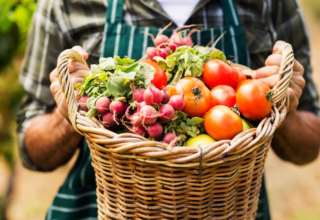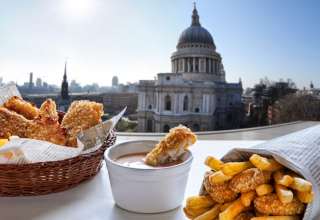You’d think good food would be scarce in a town surrounded by desert – but you’d be wrong. Paul Stafford discovers Khiva’s culinary offerings
Uzbekistan is becoming increasingly open to the outside world. The aridity of Khorezm, in the west of the country, is pierced by an oasis of turquoise-tiled minarets in Khiva, one of the Silk Road’s least-known highlights. Many of the buildings date back centuries. The city’s history is etched everywhere, from its architecture to its menus.
Passing through the gates of the Ichan Kala – the old walled town in the centre of Khiva – you encounter a living museum; 300 ancient buildings still used as homes and schools and places of worship. It’s a testament to the Silk Road’s importance and the power of the empires and kingdoms that once dominated that route. The Golden Horde Mongols and the Timurids both had an impact on Khiva’s growth – the latter empire links the area to India. As the Timurid Empire was waning in Uzbekistan, Babur, a descendant of Tamerlane (Timur), started the Mughal Empire that gave the world the Taj Mahal.
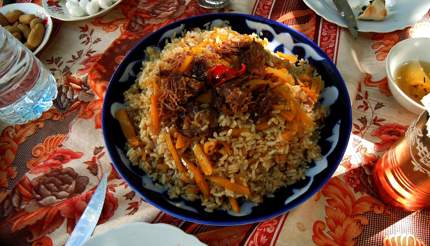
The Silk Road was bringing varied cultures and tastes to cities like Khiva when the flatness of the earth was still accepted fact. The crenelated old walls and madrasahs with high vaulted entranceways were built with the wealth acquired from Silk Road trade. That wide array of influences endures – especially on the dinner table, where the influences of India, Russia, China and the Middle East are all evident. Many of these popular dishes can be found all over Uzbekistan, but Khiva’s unique setting offers a gorgeous backdrop against which to sample them.
Plov (Pilaf)
Plov (also known as pilaf, palov and pilau) is the Uzbek national dish of rice and mutton, stewed together making a mix which is greasy in the best possible way – almost to the point of being buttery. Plov is more than just a meal, it’s a social concept. There’s a belief in Uzbekistan that a guest is not allowed to leave a without having eaten it. It’s not uncommon to be invited into someone’s home and plied with copious amounts of green tea, mountains of greasy plov and roundels of bread. At the house of Zarif (who I’d met as he dug an irrigation channel around his garden – men are experts in water management in this arid region) we sat on the floor while his wife brought us out a pot of green tea each, followed by a platter of noni bread and a plate of delicious carmine tomatoes to accompany a bowl of plov. This dish demonstrates an Indian influence on Uzbekistan’s cuisine; the first reference to it is believed to have been made in a Sanskrit text. Anything that has endured such a test of time is worth trying.
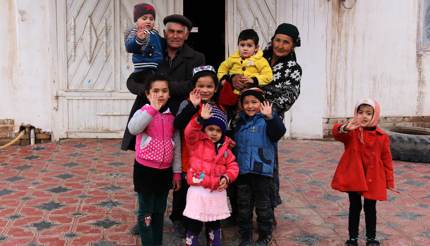
Manti
In Tibet they’re known as momo, in South Korea, mandu, and in China dumplings take on numerous names and forms including har gow, jiaozi and mantou. In Uzbekistan they are known as manti and the very ubiquity of these parcels of ingredients wrapped in a dough shell throughout the country is testament to their popularity.
In Khiva you can order up trays of either pumpkin or mutton manti. The former is a regional speciality, has a delightfully creamy filling, and is a real treat when paired with something a little more savoury, like plov. Usually they will come served with a small side dish of ayran, a tangy yogurt-like substance.
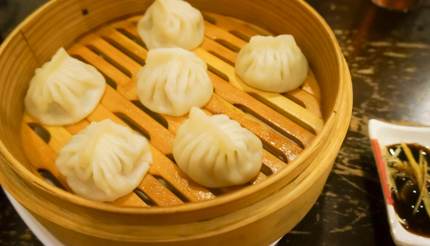
Lagman Soup
Like manti, lagman’s etymology leads us back along the Silk Road towards China. There, lamian noodles are made from dough that is stretched and pulled into long strands. They are also known as ramen.
Lagman incorporates these noodles but the name describes the whole dish, often consisting of a spicy lamb soup using thick noodles. The lamb is often served up in big chunks and can also be quite fatty depending on who makes it. Lagman often includes some vegetables such as onion and chickpeas.
Somsa
There is little to distinguish a somsa from a samosa. The tri-corner snacks are cooked tandoori style in Uzbekistan. Tandoor or tandir, as they’re known here, are volcano-shaped clay ovens. This style of cooking is common across the region, and may well have come to Uzbekistan from India, where it is known today as tandoori, although it may have originated in Ancient Babylon.
You can see tandiri ovens everywhere in Khiva. They are often by the side of the road or in courtyards tended by women in gaily coloured headscarves, while others busily imprint patterns into disks of dough the size of dinner plates. These disks are noni, Uzbekistani bread. The dough is plastered onto the heated clay walls inside the tandir to bake until firm and chewy.
Somsa are often placed on a metal rack inside the tandir and baked until the outside is crispy. The inside remains soft and chewy. The most common filling is lamb with herbs, and occasionally some onion.
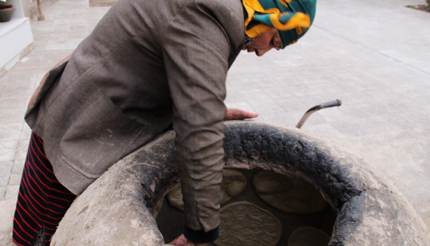
The markets
Khiva is surrounded by desert. Extensive irrigation from the Amu Darya (the River Oxus) ensures an abundance of regional produce, which often ends up adorning the stalls at local markets.
A wander through any market in Uzbekistan is an assault on the senses. This is especially true of the Khiva and the Khorezm region after miles of monotonous desert. Row after row of bright orange bowls hold heaving piles of Uzbek produce. Walnuts, apricots, prunes, almonds and raisins formed mini, succulent mountains. Much of this produce is grown and harvested locally.
Markets are an excellent place to buy ayran, which is sold in repurposed plastic bottles, often with a Coca Cola or Fanta label still on the side. The yogurt drink is also common in places like Turkey and Iraq and is usually mixed with a little salt. In Khiva, the taste ranges from tangy to sour. It is made using sheep or goat’s milk yogurt; in Khiva the latter is more likely as goats are better suited to the arid terrain.
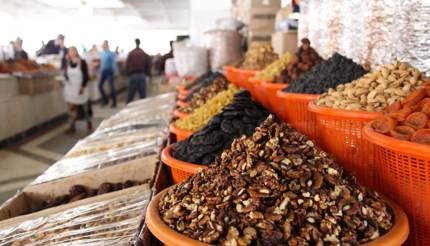
The Current Situation in Uzbekistan
On 2 September 2016 Uzbekistan’s autocratic ruler of 26 years, Islam Karimov, died. His passing ushered in a more progressive, democratic government under President Shavkat Mirziyoyev. Among his immediate changes were the improvement of political ties with neighbouring countries like Kyrgyzstan and the encouragement of tourism by making visas available on arrival for nationals of many nations, including the UK, Canada and Australia. There has perhaps never been a safer time to visit the post-Soviet state.


